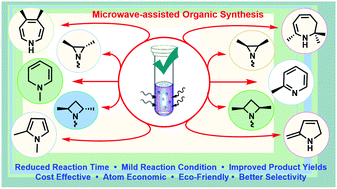The microwave-assisted syntheses and applications of non-fused single-nitrogen-containing heterocycles
Abstract
Microwave technology has emerged as a great tool for the efficient synthesis of organic compounds and it provides opportunities for chemists to achieve chemical transformations that tend to be challenging using classical approaches. Additionally, N-heterocycles are well-known for their medicinal/biological significance, along with their applications as excellent building blocks in chemical synthesis. The dominance of N-heterocycles in drug molecules and other pharmacological agents makes them attractive scaffolds, which encourages chemists to develop a wide range of strategies towards the greener synthesis and functionalization of these heterocycles. In this regard, we have collated and discussed literature relating to the microwave-assisted synthesis and the modification of non-(benzo)fused single-nitrogen-containing N-heterocycles from the past decade. The role of the microwave technique and its benefits over the conventional approach have also been emphasized in terms of overall reaction efficiency, reaction time, yield, reduced side-product generation, neat and clean reactions, chemo-/regio-/enantio-selectivity, and the use of mild reagents/reaction conditions to achieve the objectives of green and sustainable chemistry.

- This article is part of the themed collection: Synthetic methodology in OBC


 Please wait while we load your content...
Please wait while we load your content...